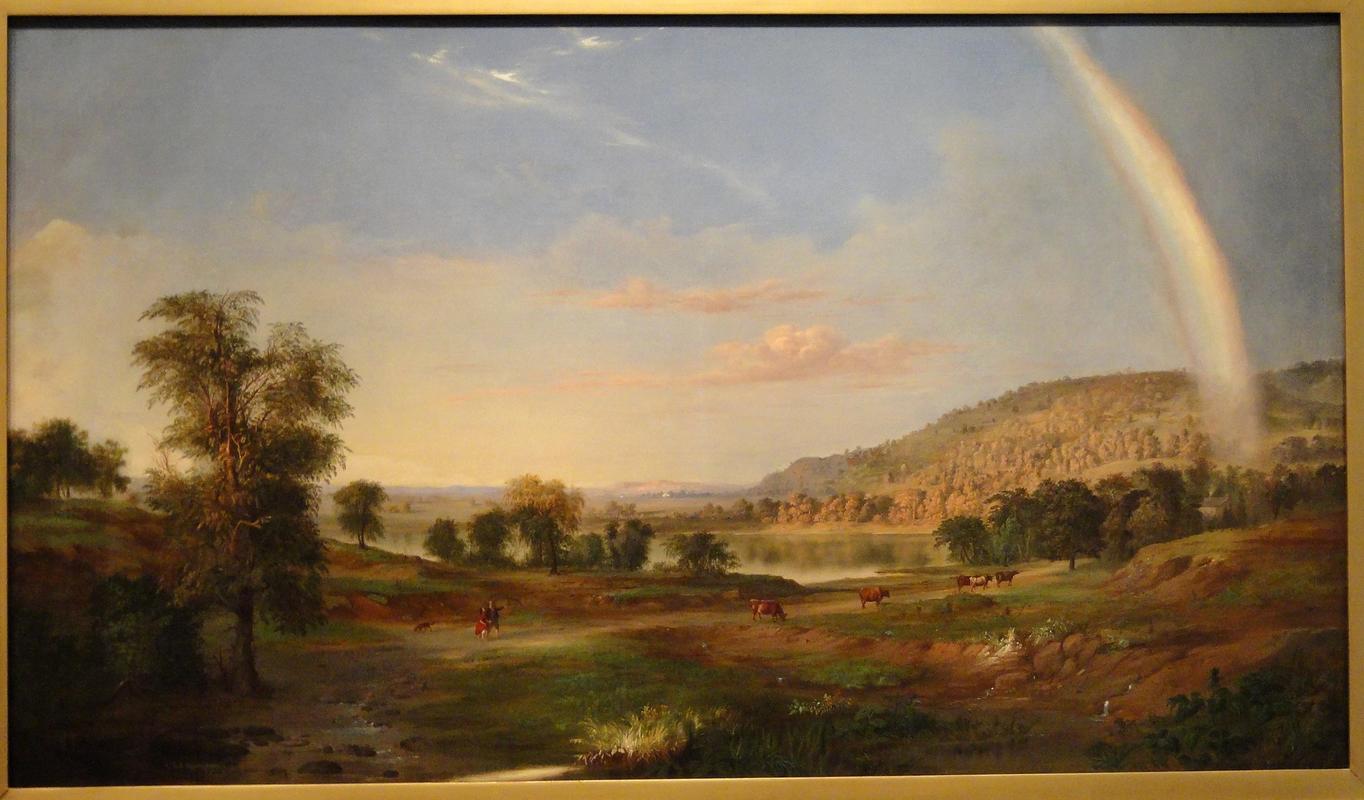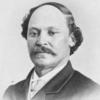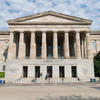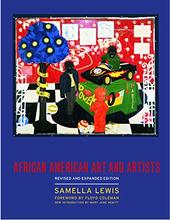More about Landscape with Rainbow
- All
- Info
- Shop

Contributor
Landscape with Rainbow by the great African American painter Robert S. Duncanson is a masterpiece that we, unfortunately, tend to overlook.
"All's well that ends well" are words that we live by: in the case of artists who suffer from mental illness, we want everyone to push through it, like Kusama has done, using it as a unique perspective from which to produce more work. Unfortunately, Duncanson's life story ends with psychiatric incarceration at Michigan State Retreat. But there's another reason that we've "inexcusably neglected" both Landscape with Rainbow and Duncanson: they remind us of the unthinkable crimes of the transatlantic slave trade that brought Duncanson's ancestors to colonial Virginia. Landscape with Rainbow represents the optimistic high note that acts as a counterpoint to Duncanson's trenchant criticism of slave society in his Land of the Lotus Eaters, based on a Tennyson poem about Homer's Odyssey, two years later. Landscape with Rainbow is a preamble to the Land of the Lotus Eaters, and we can look at them together in order to understand where Duncanson was coming from. Duncanson composed Landscape with Rainbow and Western Forest after returning from a tour of Europe—these two works prompted a Cincinnati Daily Gazette journalist to famously name him "the best landscape painter in the West."
While he was composing this work, he was multitasking, working on a portrait, and he invited a local journalist to do a Making of story in his studio. The journalist was supposed to write about the portrait, but Landscape with Rainbow was more eye-catching. The journalist wrote, "near him stood, unfinished, a wood and water scene, in which…the shadow and the light are most excellently managed. If the picture is very elaborately finished…it will be a bijou of a painting."
The whole enchilada of Duncanson's oeuvre makes explicit reference to ancient Greek mythology, influenced by the work of Thomas Cole, whose work, The Arcadian or Pastoral State set the tone for a certain idealized back-to-nature vibe which would eventually inspire hippies to strap on their sandals, pack their granola, and set out on the trail. In ancient Greek religion, Arcadia of Peleponnesus is the original stomping grounds of Pan, the deity of improvisation, outdoor music and the "unspoiled" state of nature. Wandering through the lush forest, he'd fall into a peaceful afternoon nap, and when you accidentally woke him because you forgot to put your phone on silent, his thundering shouts of rage would inspire Pan-ic, which is where we get the word "panic." Landscape with Rainbow is the world of Arcadia combined with a distinctly U.S. frontier implication, with the people gesturing toward the arc of the rainbow heading over their livestock to the rustic cottage in the grove. This is what the late Thomas Kinkade was looking to reproduce on a mass scale, and, like Duncanson, Kinkade was inclined to give a spiritual interpretation of his Arcadian canvases. For Duncanson, the rainbow is the Divine promise of eternal salvation, and it "anoints" the cabin in the foreground.
This work was featured during President Joeseph Biden's inauguration, a selection by First Lady Dr. Jill Biden, with her commenting, "I like the rainbow."
Sources
- Armstrong, Tim. The Logic of Slavery: Debt, Technology, and Pain in American Literature. Cambridge: Cambridge University Press, 2012.
- Buick, Kirsten. Child of the Fire: Mary Edmonia Lewis and the Problem of Art History’s Black and Indian Subject. Durham, NC: Duke University Press, 2010.
- Gates Jr., Henry Louis, and Evelyn Brooks Higginbotham, African American Lives (Oxford: Oxford University Press, 2004).
- Ketner II, Joseph D. The Emergence of the African-American Artist: Robert S. Duncanson, 1821-1872. Columbia, MO: University of Missouri Press, 1994.
- Lubin, David M. Picturing a Nation: Art and Social Change in Nineteenth-century America. New Haven: Yale University Press, 1994.
- Perry, Reginia A. Selections of Nineteenth-Century Afro-American Art. New York: Metropolitan Museum of Art, 1976.
- Tennyson, Alfred. Enoch Arden: Including Also the Lotus Eaters, Ulysses, Tithonus... Ed. for School and Home Use. New York: E. Maynard & Company, 1890.
Featured Content
Here is what Wikipedia says about Landscape with Rainbow (Duncanson)

Landscape with Rainbow is an oil on canvas painting by the African-American artist Robert S. Duncanson. The Hudson River School landscape painting was completed in 1859, while Duncanson was living in Cincinnati, Ohio. It has been in the collection of the Smithsonian American Art Museum in Washington, D.C. since 1983.
Background
Duncanson was born in Fayette, New York, in 1821, and he moved to Cincinnati by 1841, where he initially worked as a house painter. He joined the town's strong artistic community, which led to Cincinnati becoming known as the "Athens of the West". Duncanson's landscape art drew patrons, and he worked alongside fellow landscape artist William Louis Sonntag. They travelled to Europe together in 1853-54, where they studied the works of landscape masters including Claude Lorrain and J. M. W. Turner.
Two years after Landscape with Rainbow, Duncanson completed his largest work, The Land of the Lotus Eaters in 1861, inspired by the similarly-named 1832 poem of Alfred Tennyson and by Frederic Church's 1859 painting Heart of the Andes. Duncanson became uncomfortable in Cincinnati as the American Civil War progressed, due to the proximity of Covington in the slave-owning border state of Kentucky across the Ohio River. He left Cincinnati in 1863 to live in exile in Canada and then the UK for several years, returning to Cincinnati by 1867. He died while setting up an exhibition in Detroit in 1872.
Check out the full Wikipedia article about Landscape with Rainbow (Duncanson)













